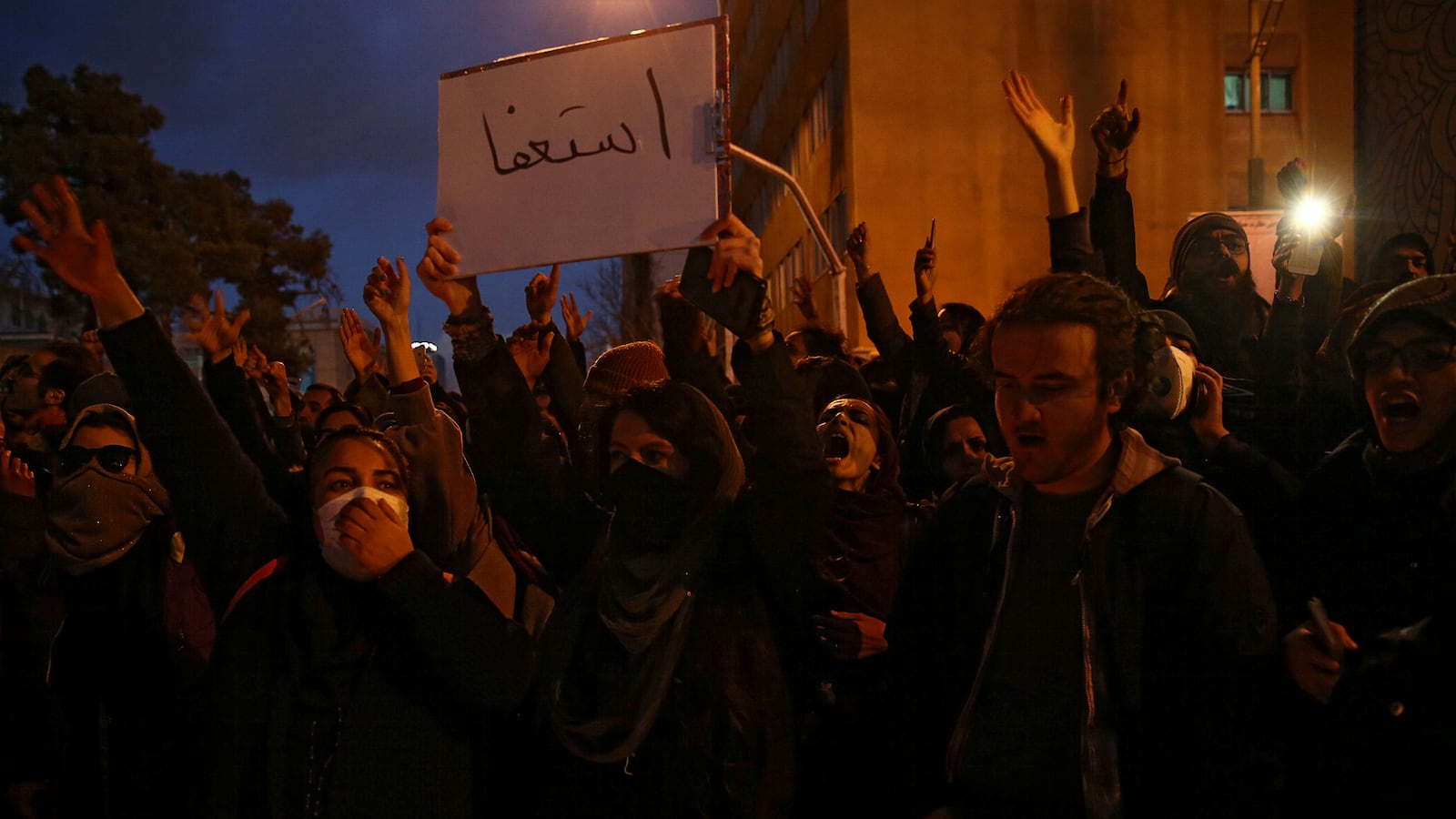These accounts also appear on IranWire, a partner publication of The Daily Beast, and will continue to be updated.
Saturday, January 11, the first day of the week in Iran’s calendar, has been a very long day for Iranians. I write these lines as the morning after has already dawned. The day started with the Iranian armed forces publicly accepting responsibility for shooting down the Ukrainian airliner, Flight 752, as covered by IranWire earlier today.
The government’s shocking announcement has led to a mass outpouring of anger. Much of the anger was aired on social media before leading to mass protests in Tehran later in the day.
The shooting down of the passenger plane is already being billed as Iran’s Chernobyl moment, the 1986 disaster in the Soviet Ukraine which exposed all the incompetence, state deception and rot in that regime. The plane crash saga has done the same for the Islamic Republic and users on social media have been pointing to some of its possible implications.
There is a widespread sense that Iran’s government was only forced into admitting its responsibility under pressure from governments such as Canada, which lost more than 60 of its citizens in the crash, most of them dual citizens of Iranian background.
“What makes me cry more than anything is that, if many of the passengers didn’t hold other citizenships, this horrible truth wouldn’t have been exposed,”one user said.
Pointing to the red flags that were raised for the slain Revolutionary Guards general Qassem Soleimani, during the public demonstrations and funeral following his assassination in a US airstrike on January 3rd, and Iran’s promises of revenge, another user posted a picture of those who died on the flight and asked: “Who will take revenge for these beautiful people? Where can we raise red flags for them?”
Many tweets were more overt in their anger. One user used expletives and dared the government to do what it recently did to quell nationwide protests: “Cut the internet! Send the IRGC and Basij forces against the people!”
More prominent figures and commentators inside and outside Iran have also been adding their criticism to the rising chorus. From his detention in Tehran, Mehdi Karroubi, a leader of the 2009 opposition Green Movement, called on the commander-in-chief, Supreme Leader Ayatollah Ali Khamenei, to resign, arguing that he lacks the basic qualifications to be the country’s leader..
Yaser Mirdamadi, an Islamic Studies scholar in London who happens to be Khamenei’s cousin, has offered a number of arguments suggesting that the Islamic Republic cares more for the lives of foreigners than its own citizens. For instance, the fact that the Revolutionary Guards missile attacks on US bases in Iraq last week carefully avoided causing any US casualties. Or the fact that the civilian flights of many countries in the region (Egypt, Jordan and Bahrain) seem to have been cancelled during the Middle East crisis whereas flights in Iranian airspace itself were allowed to continue.
A vigil for the victims of Flight 752 had been called for 5:30 p.m. in front of Tehran’s Amir Kabir University, an institution with a history of dissent. According to an eyewitness account shared with IranWire from Tehran, people started gathering even before 5 p.m. and the vigil quickly led to mass protests.
The chants became radicalized and political as the protests went on.
“Incompetent authorities must resign!” was one of the early chants; in turn, it was quickly followed by a question from the crowd: “Who is their resignation good for? They should be tried.” Chants of “Resignation is not enough, trials should be held” were the result.
But where should the buck stop? Many beyond Karroubi have dared to go all the way to the top, to the country’s Supreme leader.
“All these years of crimes! Down with this Supreme Leader!” was a slogan that rang out late in the protest. “We didn’t lose lives to praise the murderer leader,” was another.
Plainclothes officers were seen around the protests and they were met with massive jeers and expletives from the gathered people.
With hundreds killed during last year’s Iran-wide November protests, Iranians are aware of the high stakes involved in any fresh demonstrations. IranWire’s eyewitness report some of the conversations on the streets today.
“This time, even if they kill us all, we won’t go home, they must resign,” one protester said.
A young man accompanied by his concerned mother bitterly likened himself to Pouya Bakhtiari, the 27-year-old man who had gone to the protests with his mother and was shot dead by security forces, becoming a symbol for demonstrators around the country.
Unlike those protests, which were led by people suffering economic hardship, many of them in smaller cities, this time the middle classes have ignited the protests. Many speak of the need for unity between the working and middle classes to lead a viable and representative opposition movement.
Flight 752 has instantly become a national tragedy–and a source of national shame–that has caused even Iranian celebrities to join the vigil and to voice their anger through social media. The banned director Jafar Panahi, widely recognized as one of Iran’s most important and internationally renowned filmmakers, attended the vigil today along with actresses such as Hedye Tehrani, Parastoo Salehi and Hanie Tavasolli.
As the crowd of the Islamic Republic’s victims grows larger and larger, the rank of those standing against it also grows.
Report from an Iranian citizen journalist:
The crowd grew bigger minute by minute and the slogans got more and more radical. Under Hafez Bridge near Amir Kabir University of Technology, people gathered, calling for an end to murder and incompetence and accusing the country’s leaders of being “bi sharafs” — people with no conscience, morals or values.
The rally had been planned for 5:30 p.m., but people began gathering before 5:00 p.m.
Security and plainclothes agents were out in force from the outset, but when peoples’ chants became angrier, harsher and more critical, special forces pushed through the crowds on motorcycles. The crowd shouted at them: ”Shame on you!” Security forces became more heavy-handed as the chants—including “We won’t praise the murderous leader!” and “People didn’t die so we could live like this”—continued. Police tried to stop people from filming the rally so they could share it online. One demonstrator said to a girl filming, "Chant but don't film; filming makes them wild."
One university student told me the mood started off very tense all around the university area in the morning, and that the tension mounted throughout the day. And while agents tried to prevent people from recording events, they took footage of events themselves. "The university security forces are filming the students to crack down on them later in the rallies," he said. "They had done this before; they followed up on students and even university professors in the rallies based on the videos they had taken."
Then the protester shouted to the crowd, "Death to the dictator,” before turning back to me and saying, "Why should I try not to be expelled? Getting excellent grades, passing everything, getting a scholarship and going abroad and then coming back, only one day and get on a plane...” He stopped, tears welling up in his eyes.
As night fell, security forces closed off access to the university, but it made no difference—the protests continued. "Don't call us seditionists — you’re the seditionists!” people called out, referring to the regime’s term for people who take part in anti-government protests or movements. One person called out: "Please don't go home tonight; we have to stay out in the street. If we go home, just like in the November protests, they will kill us."
Amnesty International reported that more than 300 people were killed and thousands more were injured during the crackdown in November, when security forces used violence to stop nationwide protests, which began as a response to a hike in gas prices and soon turned into an outcry against the government. Reuters quoted an anonymous source as saying that the death toll for November's death was actually 1,500.
During Saturday's protests, one demonstrator told me, repeating a common theme in the crowd: "This time we will all get killed. We won't go home. They have to resign. They have to resign." He added: “They have mocked the world during recent days. They lied about the reason for the plane crash being a technical flaw. If citizens of other countries were not on the plane, they would have covered up the whole story."
Away from the university, on Somaya Street, it was less crowded. I came across a woman crying uncontrollably, her young son beside her. "Don't go far, stay here." The boy nodded his head and stayed by her side. "This morning he told me there were protests at the university. I told him not to go in the crowds. He said if something happened to him, it will happen. Remember, Pouya's mother was next to him when it happened to him” — a reference to Pouya Bakhtiari, who was shot dead during November protests in Karaj.
His mother also took part in the November protests and told IranWire: "I was chanting," she said. "I suddenly saw a flood of people coming down the boulevard where I was standing, screaming, ‘We will kill those who killed my brother.' They were carrying Pouya's body. Pouya's face was covered in blood, and this is the last image I have of him in my mind. We immediately took him to Karaj Ghaem Hospital, where we realized it was too late.”
On that day in November, security forces used tear gas to disperse the crowds, and even against people trying to take refuge in the surrounding streets. So far there have been no reports of police using such force against crowds in the January 11 protests, but people’s stories of the demonstrations will undoubtedly emerge in the coming hours and days.








